Who has the best case studies for AI solutions?
B2B buyers’ heads are spinning with the opportunities that AI makes possible.
But in a noisy, technical space where hundreds of new AI solutions and use cases are popping up overnight, many buyers don’t know how to navigate these opportunities—or who they can trust.
Your customers are as skeptical as they are excited, thinking…
- “I’m confused by the complexity of your technology.”
- “I’m unsure whether there’s clear ROI.”
- “I’m concerned about my data security.”
- “How will I integrate AI into our systems?”
- “I’m worried about employee pushback.”
- “I’m nervous about its use and governance.”
Done well, case studies about your AI solution can answer all of these questions in a way no other asset can:
With real-world storytelling, third party trust, and practical demonstrations that you can do what you promise.
To help you level up your customer stories, we’ve scoured the web for examples of the best AI case studies from companies spanning billion-dollar-juggernauts and scrappy startups.
Then, we profiled exactly what they’re doing well so you can level up your own stories!
OPPORTUNITY ALERT:
Of all of the businesses we reviewed in researching this piece, just 50% were publishing customer success stories on their websites. Want an instant competitive advantage in AI? Scale your own case study production right now!
1. Location is everything: make stories findable
Key decision-makers in B2B businesses actively seek out word-of-mouth content about potential AI partners (like you!). So the easier they can find case studies on your website, the better.
Of the AI businesses we analyzed doing case studies, most make it easy to locate their case study overview page (where prospects see your complete portfolio of case studies at a glance.)
A common journey is via ‘Resources’ in the main navigation bar, followed by a link to ‘Customer Stories’, ‘Client Stories’, ‘Case Studies’, or similar.
For example, Otter.ai has their customer stories slightly buried in their “Blog” section, with an easy-to-miss category link. We don’t love this, because there’s no clear reason someone should expect to find this type of content in the blog vs. a “Customers” section or otherwise:
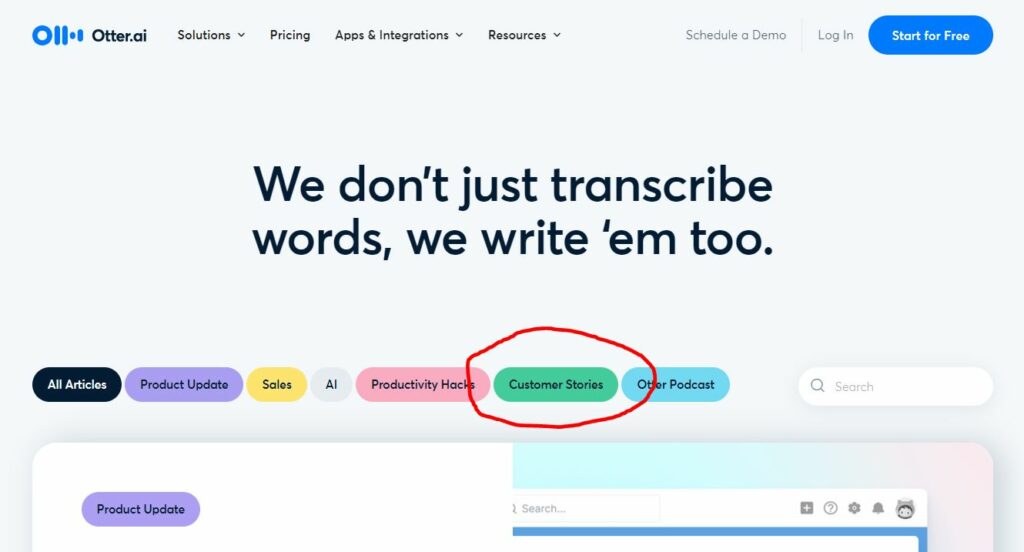
These also appear in their “Resources” section, but without any sort of jump link or clear indication you might find them there:
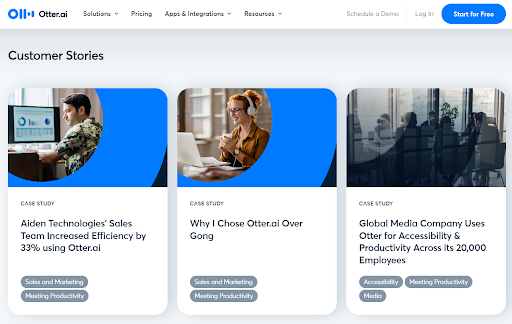
But you can do better!
In a space so skeptical and noisy, we advise you follow the likes of Presight AI and Google DeepMind and give buyers access to your customer success stories with a single click from the main navigation:
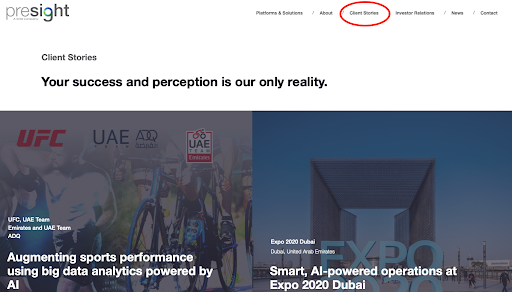
While Presight AI favors simplicity with a link to ‘Client Stories’, Google DeepMind opens the door via ‘Impact’.
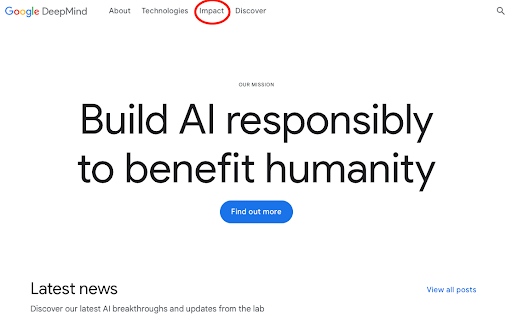
If, like Google DeepMind, your impact as an AI business extends beyond commercial customers to broader sectors and communities, using a term like ‘Impact’ works well, but ‘clear’ is better than clever here, and a simpler term (‘Customers’) may be stronger.
You’ve put in the hard work sourcing concrete proof for potential buyers; don’t put hurdles in the way of finding it.
AI case study overview pages
The ‘overview’ for your customer story page is where customers are going to either continue their journey with intention—or stumble around in the dark.
A great overview page provides a clear sense of hierarchy (what’s important?), organization (what’s here, and what’s for me?) and expectation (what’s on the other side of the click?).
Take Jasper.ai for example:
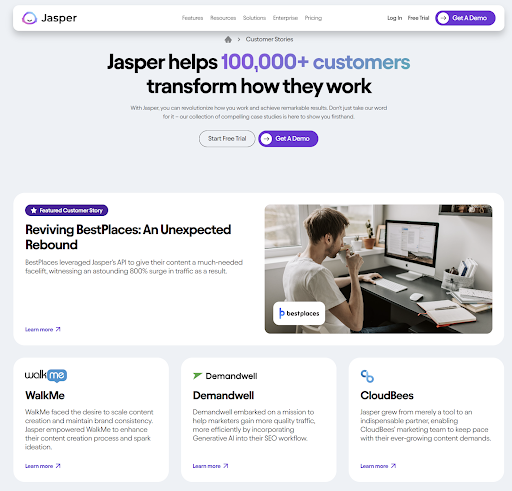
Their overview page starts strong with a compelling bit of social proof (100,000+ businesses? Holy toledo!). Having a featured story is great (more on that later), though the headline for the one in the image sort of buries the lede (800% surge in traffic!? Holy toledo!)
After that, the page offers no clear way to drill down with intention: A lead is left to scroll through the logos presented to see if there are any companies they know of, or choose a story at random—most likely the featured story or the one in the upper left of the grid.
That’s not as ideal: you’d much rather have a customer quickly find the stories most relevant to THEM.
Boston Dynamics is one AI business worth emulating on that front.
A no-nonsense intro tells prospects they’re on the right page: “Discover success stories from real customers putting our robotics systems to work.”
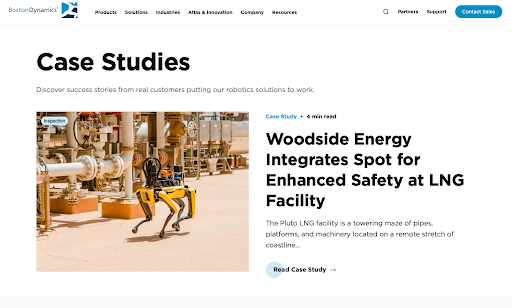
If you choose to run a featured case study on your overview page, choose a high-impact one that appeals directly to…
- A substantial result (with metrics ideally), if your audience is skeptical about ROI
- A strong quote on the alleviation of pain (if metrics aren’t available)
- A weighty promise of value if your audience is looking for something to aspire to
- A clear ‘how-to’ hook if your audience is curious about the logistics/implementation
Next, Boston Dynamics provides a comprehensive list of case studies. It’s important that prospects can easily slice and dice these to find studies that are most relevant.
Boston Dynamics does this in a couple of ways:
First, they provide filters by ‘topic’, ‘application’, and ‘industry focus’.
Second, they stamp each preview image with the main use case in that study.
Potential buyers can sort the ‘safety’ wheat from the ‘inspection’ chaff with or without filters.
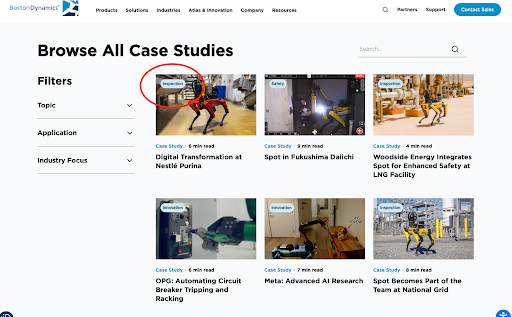
There are other ways to optimize your overview page and help buyers find relevant case studies fast.
Consider using imagery that reflects your customers’ industry or specialism. Also include company logos, so prospects recognize relatable brands.
Another AI business with a strong overview page is Dynatrace. Like Boston Dynamics, they kick off with a featured story:
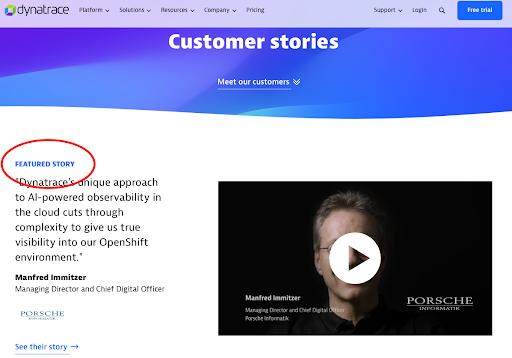
Instead of creating intrigue with a juicy title and intro, Dynatrace runs a ‘hero’ quote.
A strong quote from your interviewee, at the outset, can spike prospects’ serotonin levels, create intrigue and add credibility.
Dynatrace’s hero quote isn’t as dynamic as it could be, though it’s still strong, speaking to specific benefits (clarity and visibility).
Dynatrace offers a video testimonial (rather than written) as their featured story, something we’re all for when context for the content has been provided like it has been with the hero quote.
Video adds even more trust for buyers because they see the speaker’s reactions and emotions right there in front of them (though be careful not to conceal the interviewee’s face with the play button!)
Again, Dynatrace provides an easy-to-segment list of stories. Brand-focused imagery, company logos, and filter functionality make digging out relevant content a breeze:
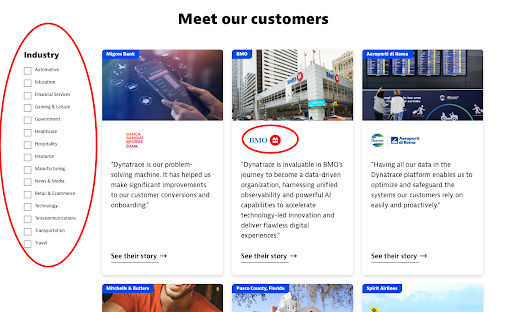
LIGHTBULB MOMENT: Want to take filtering in your AI business to the next level?
Buyers want more clarity on your ROI, so why not provide an ROI filter that highlights common KPIs/outcomes that matter to customers (e.g. savings, time savings, increased sales, reduced errors, improved retention, etc.)?
2. I can see clearly now: the importance of readability
Executed properly, case studies mimic the powerful effect of word of mouth and can be as persuasive as a trusted recommendation from friends.
But AI businesses face an added challenge: while you know your AI solution inside out, buyers could be confused by the complexity of your technology.
In any B2B business, multiple people will likely be involved in any buying decision. If your case study is meant to appeal to (typically) less tech-savvy buyers (e.g. CEOs, CMOs, etc.), then avoiding complex jargon is key.
One way to do this is to put the customers’ quotes and narrative at the core of the story.
Runway handles this with a Q&A style approach to customer stories where their customers’ responses (and thus, language) make up the entire content:
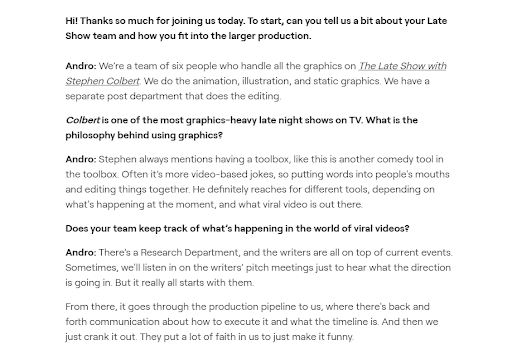
But if the Q&A style approach isn’t right for you (and it may not be), you’ve got options.
6 quick tips for writing an AI case study well
Before we dive into examples of the best written case studies for AI, here are some basics to bear in mind:
1. Every great story has a beginning, middle, and end.
Case studies follow more or less the same flow: a headline, a challenge, a solution, and the results you achieved.
2. Every good story needs a hero, so introduce yours—your client.
Your leads care about the transformation of someone like them, facing similar pressures and decisions. You want to build tension and stakes to make the story relatable, highlighting relatable pains and making the story feel personal.
Remember: heroes are rarely idiots—don’t make your customer look like one.
3. Explain in specific detail how your hero’s pain got solved.
To demonstrate your value, you want to help the reader feel the same relief, security, and confidence that the actual customer experienced. Don’t just list the features that the customer used: tie everything back to a specific, desirable outcome and a practical “how.”
4. Address specific AI-related objections in the content.
If leads worry about integration, explain it in your customers’ words. If they’re worried about security, aim for quotes covering this. A lot of this comes down to properly planning and structuring interviews with your clients.
5. Share the impact beyond the metrics (but the metrics, too.)
In the ‘results’ section, metrics matter—but so does clearly showing the transformation that has taken place. Use specific examples of what a customer can do now, or do better. Share from their output, portfolio, or specific process if you can.
Make it real with tangible examples.
6. Avoid jargon, complicated words, and creative adjectives, unless…
Jargon is to be killed with fire UNLESS your customers use that same jargon and identify with it (e.g. technical roles that prize their acronyms and lingo.)
Now, let’s get into what we saw in AI case studies out in the wild.
Across the companies we analyzed, we identified A LOT of impenetrable language and off putting jargon. A huge chunk of stories were so chewy, most non-technical B2B buyers would probably spit them out, for example:
“The ‘xxx (technology)’ provides a framework for energy operators, service providers and equipment providers to offer interoperable solutions, including AI- and physics-based models, and monitoring, diagnostics, prescriptive actions and services for energy use cases.”
These sentences are SO long. Incomprehensible jargon is everywhere. It all means next to nothing, unless you have a deep technical background in that business.
And your buyers may not!
We also found that while AI businesses should always aim for specificity in case studies, content (especially around results) trended towards being vague. For example:
“The collaboration has proven to be a fruitful venture, providing the bank with new opportunities for growth and risk management in the changing financial landscape.”
A fruitful venture? Was it as impactful as a falling watermelon or a shriveled grape?
Remember that buyers are looking for concrete, relatable, “I-can-now-do-this” proof of your capabilities. They want word-of-mouth quotes and powerful metrics.
Not rotten fruit or vague terms.
But it wasn’t all business-speaky doom and gloom. We found some great examples from AI businesses who deliver clarity and simplicity—including UiPath, who excelled at presenting the challenges their customers faced clearly and simply.
“The payroll process is complex, sensitive, and error-prone. It requires the coordination of various departments including HR, finance, and legal. Processing every wage accurately every single time requires massive effort and involves tedious manual tasks.”
UiPath make the story relatable, too, by adding human interest:
“On the micro level, missing a payment or getting it wrong simply isn’t an option when employees have bills to pay and essentials to buy.”
The pain of missing a bill because your employer messed up payroll is recognized by most people. This creates an emotional connection and sympathy in the reader.
And that probably means more engagement with the story at large!
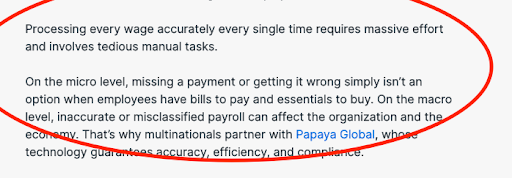
UiPath liberally sprinkles customer quotes throughout their studies, providing a constant reminder that their solution positively impacts real people in the real world, and allowing those people to speak for themselves, in their own terms.
They also seize every opportunity to add vibrant, descriptive language so buyers feel what their customer felt. It reads like a magazine feature in places:
“I was asked to look into automation,” Guez says with a sparkle in his eye, explaining that he came out of retirement to take on his current role. “At the time, RPA was a buzzword. It was still quite a new technology. We needed to get a pilot going to see how it could alleviate this pain point.”
Google DeepMind is another AI solution that tells understandable and engaging customer stories, successfully when it comes to describing complex tech in plain English:
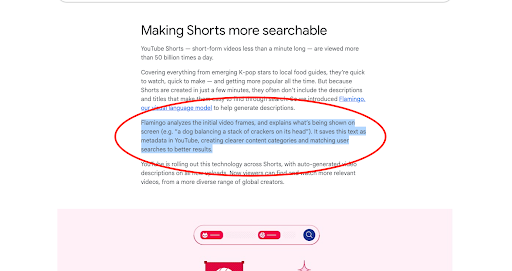
In the circled section, the company describes its Flamingo technology with both clarity and flare.
They use a funny, real-world image—a dog balancing a stack of crackers on its head—that appeals to your senses and creates a vivid and emotional connection with their solution. A visual would almost certainly have added value here!
It’s worth trying similar with your own case studies: find descriptive language, metaphors, or examples that appeal to your audience’s imagination and persuade them to reach out to you.
Google DeepMind takes care to explain every piece of technical language it uses. In another section, they talk about “improving the VP9 codec”. But they don’t leave it hanging like a curveball you can’t hit.
They add a short sentence to explain what they mean: “a coding format that helps compress and transmit video over the internet”. Home run!
3. Who cares: demonstrating value and ROI
Given the risk inherent in choosing the wrong solution or adopting a new product that doesn’t pan out, discerning B2B buyers need a clear picture of the ROI that your AI solutions provide.
Give them that, and you’re already a step ahead of the competition.
Attack the status quo
Your greatest competitors aren’t other AI solutions: they’re what your ideal customers are doing to solve the problem now—and that may very well be nothing.
To make AI customer stories compelling, you need to demonstrate the limitations and risks of sticking with the norm in order to give your solution a backdrop it can stand out against.
DataRobot does a fantastic job of this in their Freddie Mac story:
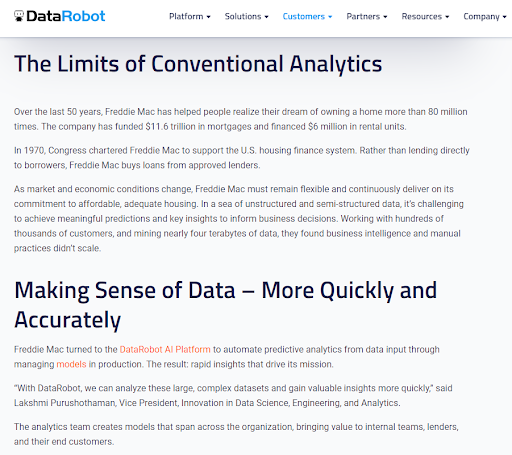
ThoughtSpot leads the “Challenge” section of their Fabuwood customer story with a comparison against a well-established alternative, Power BI:
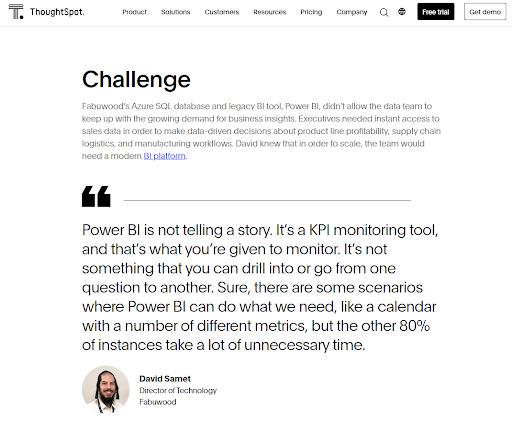
In both cases, this not only quickly establishes the shortcomings of the status quo: it also gives leads something to compare this new solution to, instantly putting ThoughtSpot and DataRobot into well-defined categories their customers can understand (“Oh, it would replace X!”) instead of some nebulous “AI” bucket (“Oh, it’s… a new… AI… thing.”)
The importance of metrics in demonstrating ROI
Across the AI businesses we analyzed, there was a noticeable lack of performance metrics in their case studies. This suggests that either customers aren’t seeing strong returns or, more likely, AI firms and their customers find it a challenge to quantify AI investments.
Most organizations using your technology will have considered baseline performance pre-AI, put measurable goals in place and be tracking progress.
To strengthen the impact of your case studies, ask them to provide this quantifiable proof during your interview process. The key here is to be specific about what you ask for.
So what metrics should you ask customers to dig out for you?
Of course, it depends on your products and customers’ goals for using them, but here are some general tips.
Anything related to sales is gold for prospective buyers, such as revenue growth, margin improvements, conversion rates, and customer lifetime value.
Ask, too, about improvements to operations and efficiency, including cost savings, error reduction, productivity improvement, and process optimization.
As well as hard returns, try to unearth softer ones, such as the human impact on your hero, as this will strongly resonate with B2B buyers in similar roles.
Now let’s check out some examples.
Some AI companies do attempt to add weight and muscle to their case studies with metrics. But even the best examples we found have work to do.
Numenta, for example, showcases a hot metric in the headline below. 20x inference acceleration is a big sell for customers operating in the computing space, because it improves the performance of their machines:
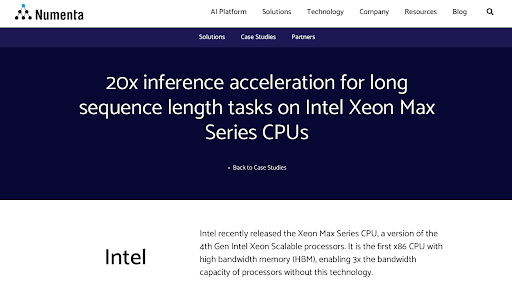
To make the headline more intriguing, Numenta could explain the result and impact of this 20x increase in processor speed on their customers. For example, sharing revenue growth or profit margin improvements off the back of this high-speed processor would give other buyers a tempting result they’d want to replicate.
Back to UiPath now, who also use metrics to show how customers reap the benefits of their AI solutions. Here, metrics take center stage at the start of a story:
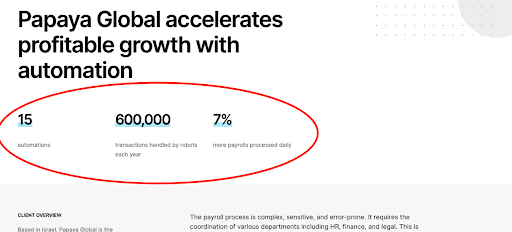
UiPath has chosen operational metrics here—the number of automations implemented, number of transactions handled by robots, and growth in payrolls they process each day.
While they do provide quantifiable evidence of the impact of AI to their business, they could go further.
For example…
- If more transactions are being handled by robots, how much time is that saving the business?
- Has staff retention improved with more dependable payroll?
- Have they saved costs as a result of greater efficiency?
AI has clearly provided Papaya Global with significant benefits. With a little more work—and arguably more structure at the interview stage—UiPath could have left readers with no doubt about their solution’s ROI.
Going beyond metrics and into examples
Several solutions had demonstrations of outcomes—for example, galleries of outputted imagery or samples of produced work. Kaiber has a lovely gallery, as you’d expect from a very visual solution:
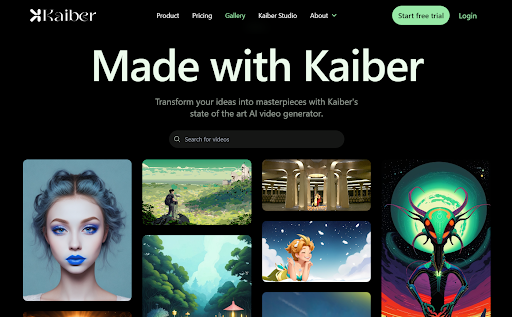
Meanwhile Tome comes to bat with stories that disambiguate a use case and explain an outcome that is valuable, but not necessarily quantifiable, like creating a “Personal radio station”:
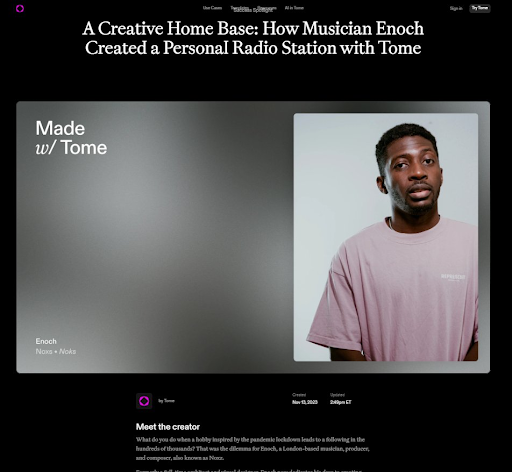
These are also valuable in terms of demonstrating practical value, but business buyers also speak in terms of ROI, especially when making a case to their bosses for a purchase.
4. Don’t fight it: turning employee pushback into employee buy-in
An ongoing barrier for businesses looking to implement AI solutions is the risk of employee pushback: will staff actually adopt and support new technologies that may fundamentally change how they work?
Strategic AI companies can use customer success stories as a weapon to shoot down those objections.
We found a number of AI businesses using case studies to share the message: “AI is not going to take your job!”
In this case study, UiPath’s customer explains the continued importance of having ‘a human touch’ in the business:
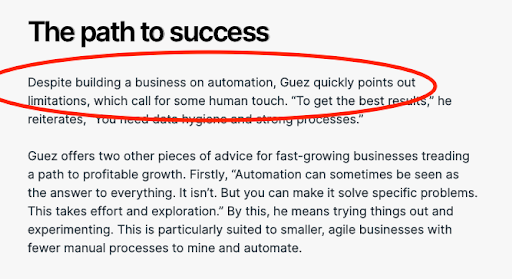
UiPath doesn’t want its customers to say their AI solves everything. Their goal is to make businesses more efficient and successful—not to jeopardize job security.
OpenAI also uses its case studies to battle employee pushback. One powerful line reads:
“Ironclad’s goal in using AI has always been to help people do more, not to replace them with technology.”
Their message couldn’t be clearer to companies looking for an AI solution, while avoiding conflict on the frontline.
Meanwhile, Reply.io works to overcome potential objections by focusing on where teams are likely to take issue: with the quality of work done by AI relative to a human.
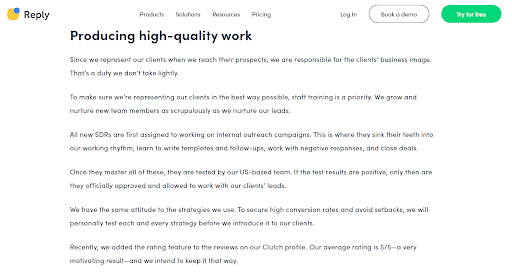
They cover this potential staff objection right in the story, proactively shooting a barrier to adoption out of the sky.
4. Muzzled, not muted: make ‘anonymous’ compelling
In an ideal world, all your customers would let you tell the story of how you helped them succeed. In the real world, customers aren’t always comfortable publicly talking about their AI use, even when they’re thrilled.
Sometimes, they’re constrained by their legal departments. Other times, they make a call that the story’s just too sensitive and decline to participate.
One way around this is to ask customers to share their story anonymously. But can stories be compelling weapons of mass conversion if you don’t mention any names?
Yes, absolutely.
Let’s look at how one of the AI companies we analyzed, C3 AI, produces powerful anonymous studies, like this one:
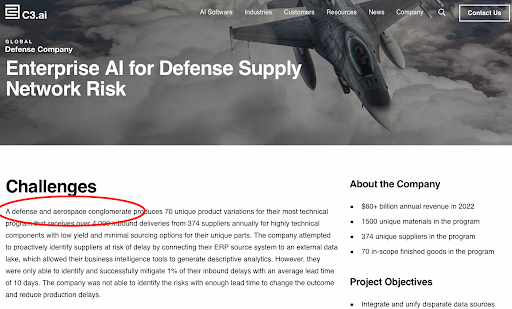
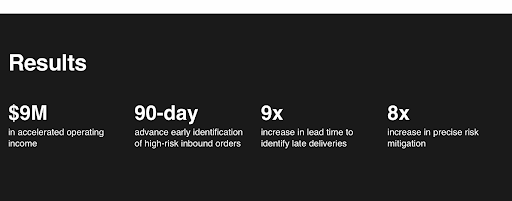
C3 AI anonymizes this case study, but manages to maintaining most of its impact by:
- Demonstrating the prestige of the customer with a sidebar packed with detail (see ‘About the Company’ in the graphic above)
- Turning anonymity into a plus by sharing metrics the company might not make public if their name was associated with it (ie, $9M in accelerated operating income)
- Including it alongside multiple case studies that are named. Taken together, the anonymous study has as much credibility as named studies.
What more can you do?
You can further retain the power of anonymous studies by:
- Including compelling, in-depth quotes from the people involved, swapping out names for descriptive titles and gender-neutral pronouns.
- Providing as much detail as non-anonymous studies; telling the full story of why the customer chose you, what their journey looked like, and how you made a difference. You don’t need to provide names to demonstrate how you delivered real ROI.
5. Trust me, bro: getting your leads to believe the hype
As a B2B buyer, it’s hard to know whether companies are spinning you a genuine opportunity—or a yarn. Trust is tough to earn and keep.
Case studies immediately cut through the sales spiel and provide concrete proof straight from customers’ mouths.
By nature, case studies are powerful trust builders because they show rather than tell. You can maximize that opportunity by including additional ‘trust’ signals throughout your stories.
Devices such as customer quotes, customer headshots, and customer logos all do the job.
During our analysis of AI case studies, we found most companies use direct customer quotes to foster trust.
In an environment where many AI businesses have an ROI problem, customer quotes are critical. Buyers can hear exactly how other people just like them have benefited from your solutions, proving that your brand is worth buying.
OpenAI uses quotes well to enhance the credibility of their customer stories:
GoGwilt recalled the initial excitement within his legal engineering team as they saw what OpenAI’s models could do for contracting. “There was the first moment of the team saying, ‘Wow, this is producing work at the level of a first-year associate,’” he said.
It’s powerful for a buyer when they hear someone—in a role that resonates with their own—describing the ‘wow’ moment your product provides.
Here’s another example of how customer quotes can build emotion, trust, and buy-in:
The engineers quickly moved on to a prototype—and experienced another “wow” moment. “Integrating GPT-4 into our contract editor and just seeing how seamless and powerful it felt made it pretty easy for us to invest further into productizing and getting it to customers,” GoGwilt added.
Using customer headshots, customer logos, and embedded video are other solid ways to signal trust.
Video testimonials, in particular, increases the impact of customer success stories because viewers see a customer’s emotion and sincerity in real time.
Here’s another great example of this from DataRobot, combining customer testimonial videos with written quotes to hammer home the legitimacy of their story:
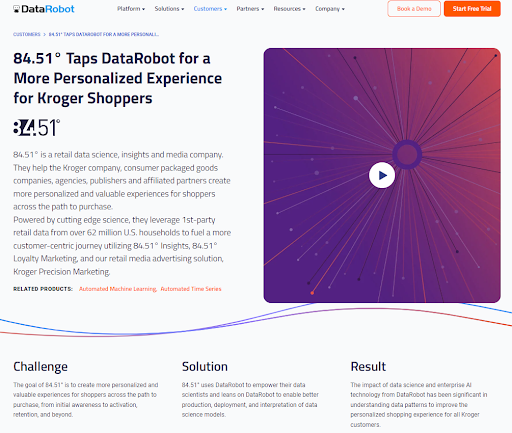
Similarly, WorkFusion regularly brings video into their enterprise customer stories, adding depth and legitimacy while sharing the genuine human perspectives of the impact:

6. Picky eaters: how to make AI case studies valuable for time-starved buyers
We’re big believers (supported by data) that prioritizing long-form customer stories on your website improves online visibility and provides proof of your expertise and authority.
But time-starved B2B buyers also need to be catered for.
That means presenting success stories in a scannable (or watchable) way that helps even wandering eyeballs catch the best bits.
Formatting and design devices, including top and sidebars, pull quotes, and images all help readers find proof of your capabilities without reading the entire study.
PROS is one company setting good scannability standards in their customer stories, like this one on Lufthansa:
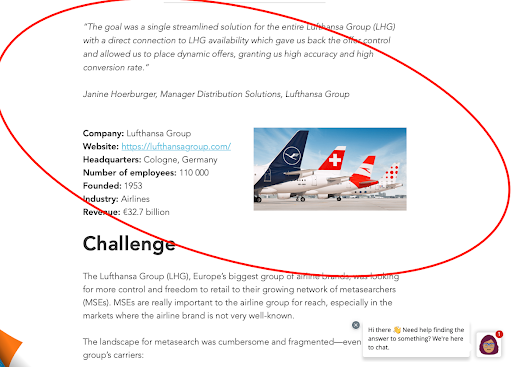
They use exploded quotes, a snackable company round-up, short paragraphs, and white space to help buyers derive value without reading every word.
Using a hero quote at the outset adds instant credibility, even for scanners.
C3 AI does something unique by providing a visual timeline of events in their Shell customer story. This is a great idea for showing your customers’ journey in a bite-sized and accessible way:
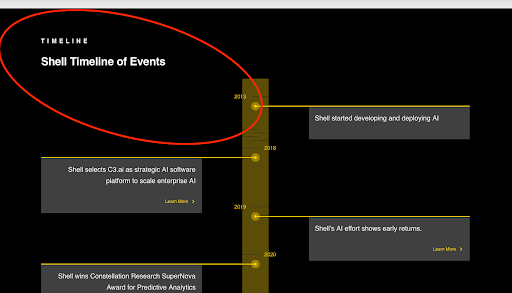
Dynatrace runs a snappy sidebar, complete with a snack sized story round-up:
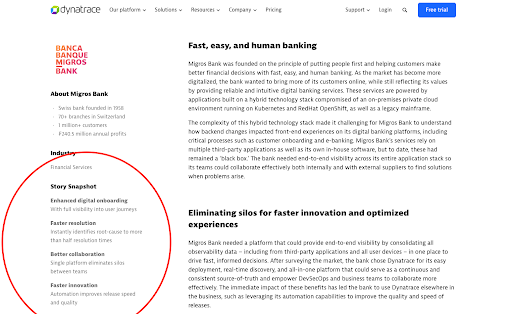
Dynatrace also uses a bulleted list, ‘Life with Dynatrace’, to highlight the key benefits of partnering with them, without oceans of convoluted narrative:
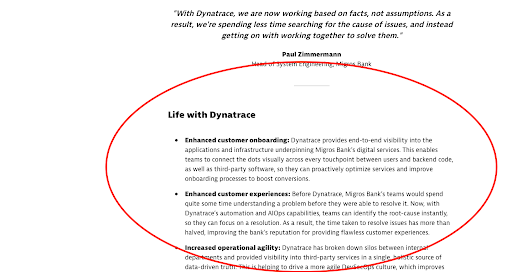
Boston Dynamics also performs well on scannability. Colorful images of robotic technology and punchy crossheads are used to break up long runs of text:
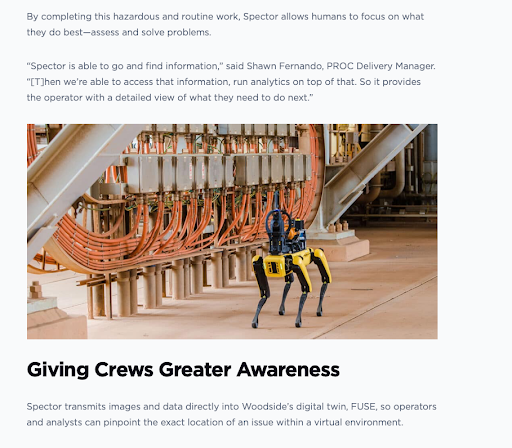
Shoutout to OpenAI, too, which uses exploded quotes as text breakers to make its formatting friendlier. Rushed readers are constantly rewarded with quotes from happy customers as they scan:
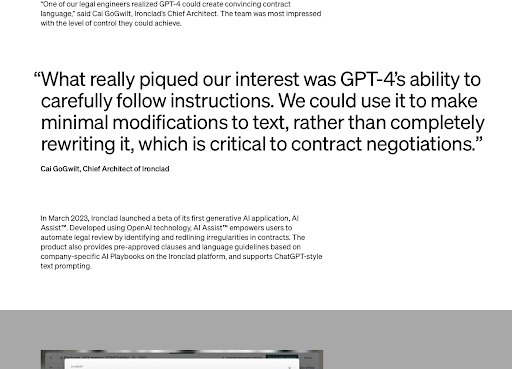
Google DeepMind provides an always on-screen navigation bar to help readers jump to the sections that most interest them:
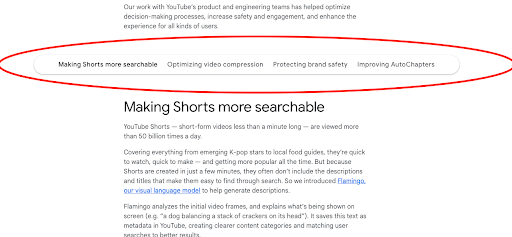
If you do choose to use a topbar or sidebar in your studies, include impactful metrics in there, like UiPath does:
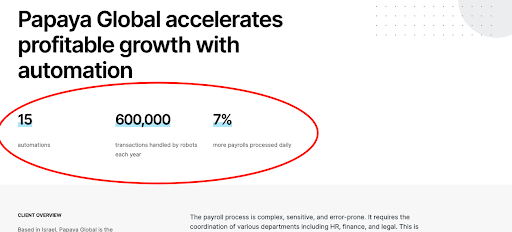
Because you’ll be drawing buyers to this section with your amazing performance metrics, be sure to include a call to action (the logical next step you want a buyer to take).
And don’t forget to include a CTA at the end of every story, too.
By making studies scannable, you ensure that every reader is covered.
One final observation: if you put the hard work into creating case studies, you will hook in target buyers looking to learn even more. Encourage extra engagement by including ‘keep reading’ or ‘share on social’ options at the end of your stories, just like Boston Dynamics do:
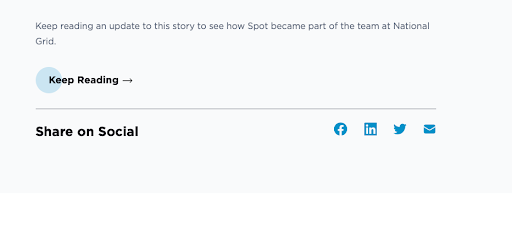 UiPath, yet again, sets a high bar keeping leads and prospects on their website. They provide a list of related case studies, which are (I checked) correctly segmented into whatever industry prospects are currently exploring, encouraging them to hear from more… and more… of UiPath’s happy customers:
UiPath, yet again, sets a high bar keeping leads and prospects on their website. They provide a list of related case studies, which are (I checked) correctly segmented into whatever industry prospects are currently exploring, encouraging them to hear from more… and more… of UiPath’s happy customers:
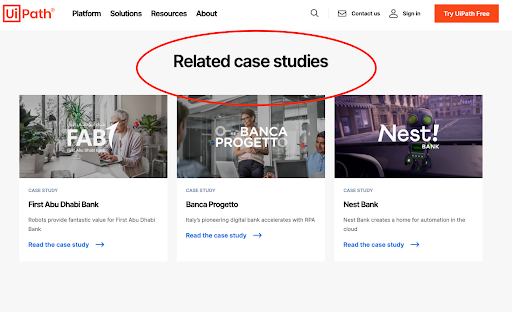
The last word: putting it all together
Now you’ve seen what other leading AI businesses are doing with their case studies, the question is this:
Are YOU ready to suck in more leads and buyers by producing high-impact case studies that prove your ROI and credibility?
Let’s recap some of the findings and recommendations from our analysis of leading AI case studies:
- AI companies can answer buyers’ biggest questions and concerns with well-crafted and well-presented case studies.
- Of the AI companies we analyzed, fewer than 50% had even a single case study case on their website. Scaling your own AI case study production (right now!) will give you an instant advantage.
- Make case studies super-easy for buyers who are looking for solutions like yours to find.
- Use simple, straightforward language to explain your technology, so technical and non-technical decision-makers can understand
- Differentiate your AI business in a noisy marketplace by providing quantifiable metrics. Clearly show the ROI customers get when they work with you.
- Anonymous studies about AI solutions can be as impactful as named studies. When customers know they won’t be named, they often provide mic-drop worthy metrics and personal details about their journey they otherwise wouldn’t feel comfortable sharing.
- Enhance case study credibility with customer quotes, customer imagery, customer logos, and video testimonials.
- Make your AI case studies scannable, so time-starved buyers understand all your capabilities and the results you get for customers without reading every word.
Need help producing written AI case studies or video testimonials?
At Case Study Buddy, we have the knowhow, streamlined processes, and team to make it easy for you.